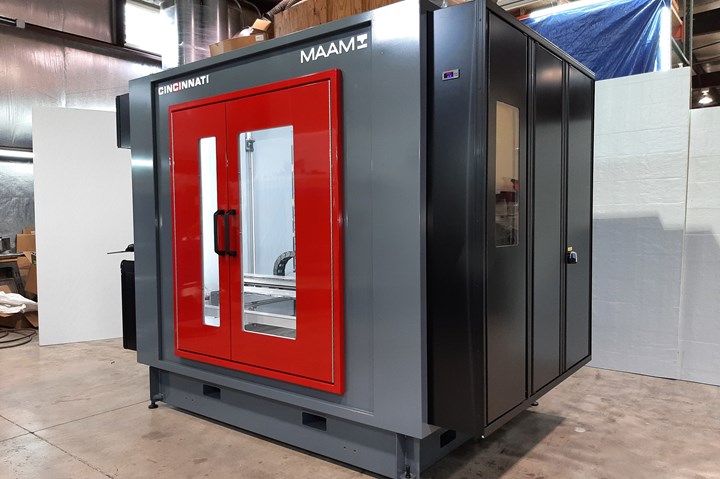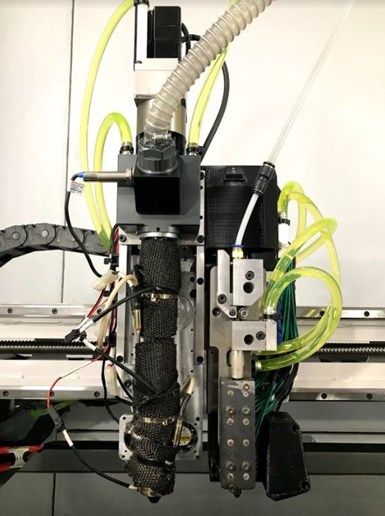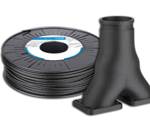Ohio State CDME advances AM technology with Cincinnati Inc. MAAM printer
With an additive machine that prints ULTEM, PEEK and PEKK thermoplastics, university researchers and students expect to take 3D printing to new heights, including printing a fully functional turbine and internal combustion engines.

Cincinnati Inc. Medium Area Additive Manufacturing (MAAM) machine. All Photo Credit: Cincinnati Inc.
Build-to-order machine tool manufacturer Cincinnati Inc. (CI, Harrison, Ohio, U.S.) is partnering with Ohio State University’s Center for Design and Manufacturing Excellence (CDME, Columbus). CI has provided the center with one of its Medium Area Additive Manufacturing (MAAM) printers, an industrial-sized additive machine built for production manufacturing and compatible with any thermoplastic filament or pellet material. According to CI, CDME researchers and students will now be better equipped to advance additive manufacturing (AM) technology and techniques.
CI notes that, with a rigid welded frame, CNC controls and the latest extruder technology, the MAAM printer was designed to print materials accurately and consistently at speeds currently unmatched in the market.
“CI’s MAAM printer expands the diversity of printers we have to offer at CDME and further differentiates Ohio State as one of the global leaders in additive manufacturing,” CDME Executive Director Nate Ames says. “The ability to 3D print ULTEM, PEEK and PEKK at meter-scale opens a new world of manufacturing opportunities.”
CDME facilitates innovation for a wide breadth of AM practices. The center’s novel approach to applied engineering, technology translation and workforce development is executed in its 32,000 square-foot advanced manufacturing facility on Ohio State’s West Campus. The center houses more than $5 million worth of additive manufacturing equipment, including industrial 3D printers capable of processing metals, polymers, composites, biomaterials and ceramics.
“Ohio State provides the engineering resources and experience in AM that will help CI further develop MAAM’s potential in material and parameter development, as well as discovering new applications for the technology,” Alex Riestenberg, additive manufacturing product manager at CI says. “Having a partner like Ohio State just two hours away from our headquarters provides logistics advantages for our team and easy access for potential customers.”
CDME Director of Additive Manufacturing Edward Herderick adds that, in partnership with CI, Ohio State students and researchers have a roadmap for materials innovations and prototype vehicle manufacturing, as well as advancing the status quo in industrial additive manufacturing.

With a stated organizational goal of enhancing U.S. manufacturing competitiveness, CDME enables undergraduate students to work in a manufacturing environment that matches what they’ll experience after graduation and in their careers. That experiential education includes leveraging the latest 3D printing equipment and tools, including the MAAM machine. “You can't fake real, and CDME students are directly contributing to customer projects,” says Herderick.
Along with training the next generation, the CDME team also has its sights set on pushing its 3D printing practices to new heights. “We've already declared an internal mission to design and print a fully functional turbine and internal combustion engines using the MAAM printer,” Ames says. "Who knows, maybe Elon Musk will call us to power his terrestrial vehicles for Mars.”
If you're interested in collaborating with CDME on an AM project, you can connect with Edward Herderick via email at herderick.2@osu.edu.
Related Content
-
The potential for thermoplastic composite nacelles
Collins Aerospace draws on global team, decades of experience to demonstrate large, curved AFP and welded structures for the next generation of aircraft.
-
TU Munich develops cuboidal conformable tanks using carbon fiber composites for increased hydrogen storage
Flat tank enabling standard platform for BEV and FCEV uses thermoplastic and thermoset composites, overwrapped skeleton design in pursuit of 25% more H2 storage.
-
Thermoplastic composites: Cracking the horizontal body panel nut
Versatile sandwich panel technology solves decades-long exterior automotive challenge.
















